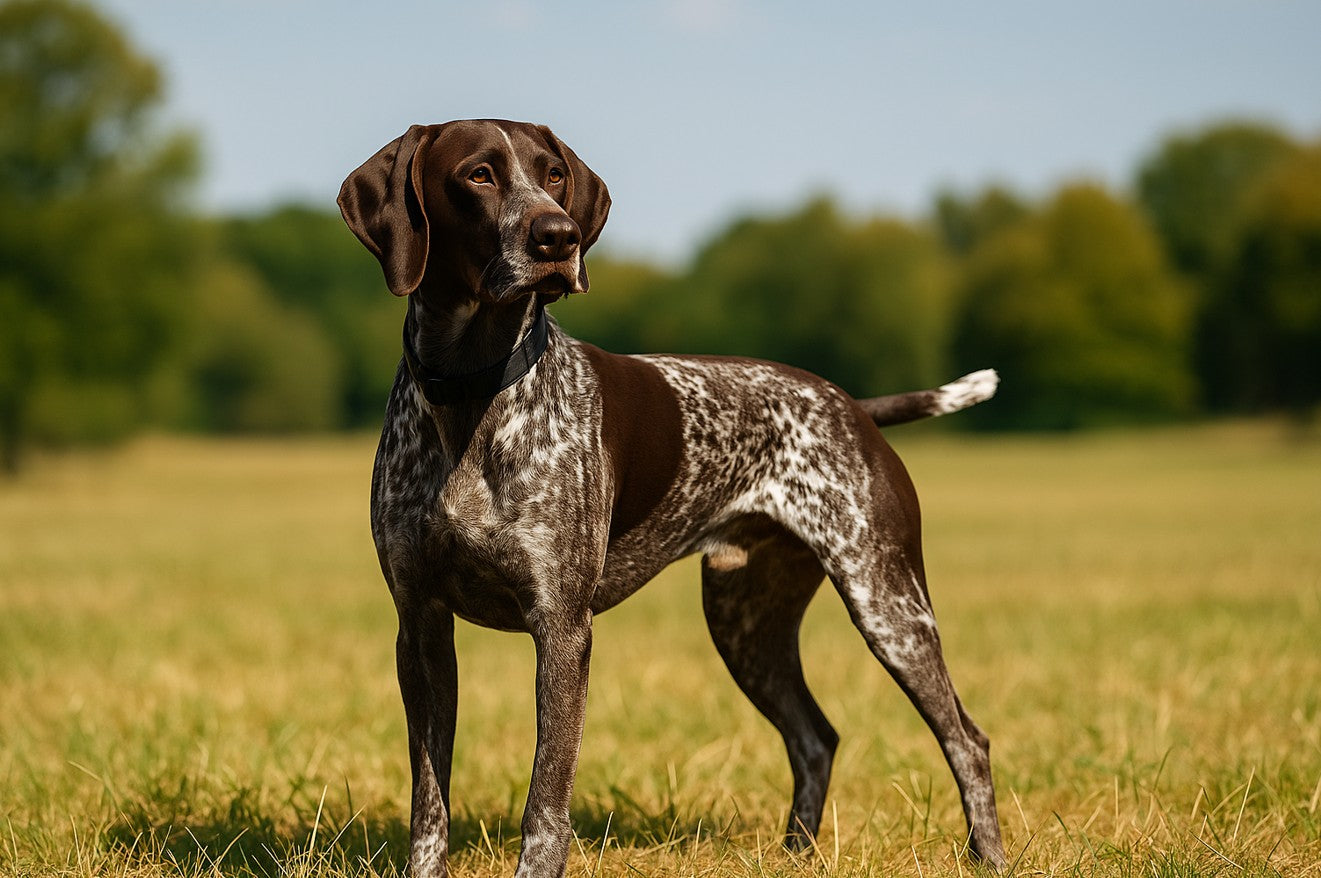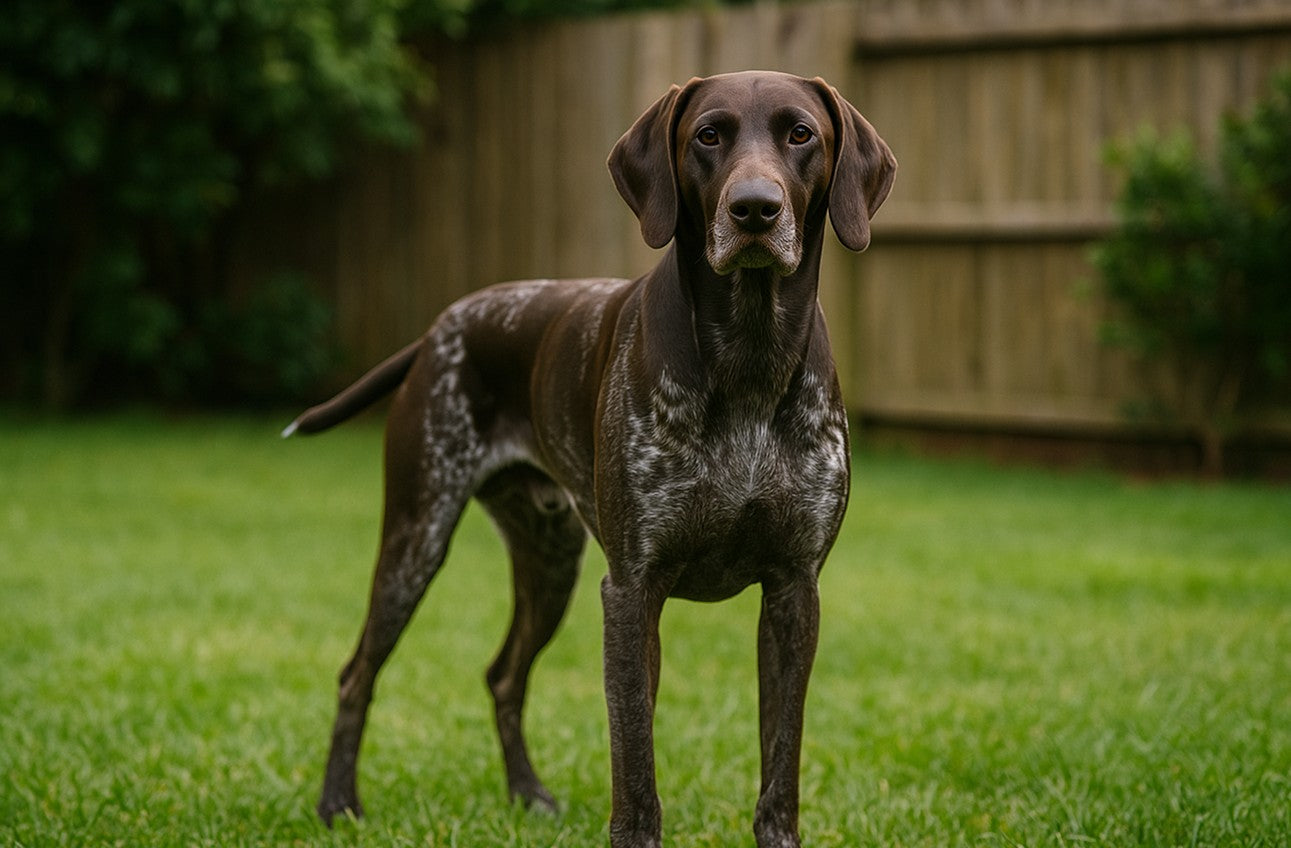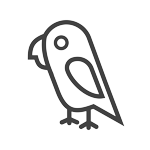
German Shorthaired Pointer: The Ultimate Guide to This Energetic Breed
So you’ve come across the German Shorthaired Pointer and thought, “Wow, what a stunner!” And you wouldn’t be wrong. With their sleek build, expressive eyes, and that unmistakable energy that practically hums through their veins, these dogs are impossible to ignore. But behind the good looks? A working dog with the heart of an adventurer and the loyalty of a best mate.
This isn’t the type of dog you grab on a whim. GSPs (that’s what the cool dog parents call them) are high-octane, brainy, and emotionally switched-on. If you're not out hiking, training, or at least throwing a ball around, they’ll come up with their own activities—and spoiler alert, your garden beds or socks might not survive.
Whether you're eyeing up German Shorthaired Pointer puppies, wondering if that blue-ish coat you saw is legit, or trying to figure out how long they’ll be your running buddy, this guide’s got you covered. We’ll dive into their history, temperament, health, colours, and what daily life with a GSP actually looks like—chaos, cuddles and all.
Let’s jump in. Just don’t expect your Pointer to walk—they’ll be sprinting ahead.
A Look at the German Shorthaired Pointer’s History
If there were ever a dog breed built with purpose in mind, it’s the German Shorthaired Pointer. Born from necessity and refined through careful breeding, this high-performance pooch wasn’t made for lazy days on the couch—though they won’t say no to a nap on a soft bed after a long day in the field.
Origins in 19th Century Germany
The GSP was developed in Germany in the mid-to-late 1800s by breeders who had one clear goal: create the ultimate all-purpose hunting dog. They wanted a dog that could do it all—track game on land, retrieve from water, point birds, and handle varied terrain. And they succeeded, big time.
Breeders mixed a variety of dogs, including:
-
The German Bird Dog, descended from the Spanish Pointer
-
Bloodhounds (for their superior scenting skills)
-
And later, English Pointers to add speed and refinement
The result? A noble-looking, athletic dog with the scent-tracking prowess of a hound and the sharpness of a sporting gun dog.
Versatile Gun Dog with Natural Talent
German Shorthaired Pointers are part of the “Versatile Hunting Dog” group, meaning they’re built to hunt, point, and retrieve both on land and in water. They’ve got webbed feet, a water-resistant coat, and an instinctual point that kicks in as early as 8 weeks old.
Unlike breeds trained for one job, GSPs were bred for versatility—flushing game, retrieving birds, trailing deer, even working alongside falconers. That natural instinct and intelligence are still very much present today, whether they’re being used in field trials or fetching tennis balls at full tilt in the backyard.
Recognition and Global Spread
The breed was officially recognised by the German Kennel Club in 1872, with the first studbook entries appearing not long after. They made their way to the United States in the 1920s and were recognised by the American Kennel Club in 1930. In Australia, they’ve gained popularity with hunters, sport dog enthusiasts, and active families alike.
So while your GSP may be snoozing peacefully at your feet, deep in REM sleep and twitching away, their DNA still tells the story of generations of skilled hunters and loyal companions. They’re working dogs through and through—with a splash of cuddle bug.
Personality, Appearance & Temperament

Living with a German Shorthaired Pointer is like signing up for life with a personal trainer, a shadow, and a bit of a cheeky clown—all rolled into one. These dogs are full of character, bursting with stamina, and emotionally tuned in to their humans. They're not for the faint-hearted, but they’re pure magic for the right family.
Natural-Born Athletes with a Soft Side
Let’s get this out of the way—German Shorthaired Pointers are not couch potatoes. They’re built to move, think, chase, and explore. Originally bred to hunt across diverse terrain, they’ve retained their working drive even when they’re lounging in a suburban home. Daily exercise isn’t a luxury—it’s a requirement.
Despite all that muscle and energy, they’re total softies with their people. GSPs are famously affectionate, and many become Velcro dogs—following their humans from room to room. They thrive on connection and will sulk if left alone too long. These dogs want to be in your business, your bed, and your lap (yes, even the 30kg ones).
Temperament Traits to Know
-
Loyal & Devoted: They build strong bonds with their family, often favouring one person slightly more
-
Intelligent & Eager: Quick learners who love structured training—but boredom can lead to mischief
-
Friendly but Reserved: Social with familiar people and pets, though may be aloof with strangers
-
Sensitive Souls: Respond best to positive reinforcement and gentle corrections
German Shorthaired Pointer Size, Shape & Build
GSPs have a distinctive silhouette—lean yet muscular, with long legs built for speed and stamina. Their movement is smooth and efficient, almost floating when they run full pelt across a paddock.
-
Height:
-
Males: 58–64 cm
-
Females: 53–59 cm
-
-
Average weight for German Shorthaired Pointer:
-
Males: 25–32 kg
-
Females: 20–27 kg
-
They carry themselves with confidence but not aggression, always looking alert and ready to work or play.
Living with a GSP: The Day-to-Day Reality
These dogs do best in active homes—think runners, hikers, hobby farmers, or families with big backyards. Without proper stimulation, they can become destructive or anxious. They're also incredibly in tune with their humans’ mood, often sensing stress or sadness and trying to comfort you.
Don't be surprised if your GSP insists on being part of everything—from family barbecues to bedtime stories. They don’t want to be left outside while the “pack” is inside watching telly.
Looks, Colours & Markings – Let’s Talk Coats
The German Shorthaired Pointer isn’t just known for its athleticism—it’s a total head-turner. Sleek, stylish, and often covered in stunning speckles and patches, this breed is instantly recognisable. Whether it’s the classic liver-and-white coat or something a little rarer like black or even “blue,” GSPs have a distinctive beauty to match their brains and brawn.
The Signature GSP Look
These dogs have a lean, sculpted body that screams purpose. Their coat is short, dense, and feels a little coarse to the touch—not fluffy or woolly. It’s water-resistant by nature, helping them stay dry while working in the field or paddling through creeks. Their long, floppy ears, almond-shaped eyes, and docked tail (in many countries, including parts of Australia) round out the look.
They tend to carry themselves with a confident, alert posture—like they’re always ready to go. Because they are.
German Shorthaired Pointer Colours
There’s quite a bit of variation within the breed, and some terms can be confusing if you’re new to it. Let’s break it down clearly:
Liver
-
The most common colour
-
Ranges from deep reddish-brown to chocolate
-
May be solid or paired with white markings
Liver and White
-
Can appear as patches, ticking (freckles), or roaning (blended speckled pattern)
-
Extremely common and often seen in working lines
German Shorthaired Pointer Black
-
Less common but recognised by many international kennel clubs (e.g., FCI and ANKC)
-
Some breeders specialise in this colour line
-
May be solid black or black and white (similar patterns as liver)
German Shorthaired Pointer Blue
-
Not an official colour
-
"Blue" typically refers to a diluted black or liver tone or a misinterpretation of heavy roaning
-
Clarification: You won’t find true “blue” GSPs listed in reputable breed standards, but people sometimes call extremely roaned or dark grey-ish coats “blue” casually
Unique Markings
-
Ticking: Flecked dots over white areas
-
Roaning: Blended mix of white and liver or black, giving a dappled appearance
-
Patches & Solid Areas: Often appear on back, ears, or base of the tail
Their coat doesn’t just look good—it’s practical too. Low-maintenance, easy to clean, and built for a dog that rarely sits still.
How Long Do They Live? – Lifespan & Longevity

One of the lovely things about German Shorthaired Pointers? They’re not just in it for a good time—they’re in it for a long time. With the right care, these athletic companions often enjoy many healthy, happy years by your side.
Average Lifespan of a German Shorthaired Pointer
-
The average lifespan of a German Shorthaired Pointer is 12 to 14 years.
-
Many live even longer with excellent nutrition, regular vet care, and plenty of physical and mental exercise.
That’s pretty solid for a medium-to-large breed, especially one as active as this. Their hardy working-dog heritage gives them a strong constitution—though they still need your help to live their best life.
What Impacts Their Life Expectancy?
Several factors influence how long your GSP might live:
Genetics
Choose a reputable breeder who health tests for common issues like hip dysplasia and eye conditions. A good start makes all the difference.
Diet & Weight
Keeping your Pointer lean is key. Obesity shortens a dog’s life significantly, especially in breeds with joint risk. Feeding a high-quality diet based on their activity level and size supports longevity.
Exercise & Mental Stimulation
This breed doesn’t just want exercise—they need it to stay physically fit and mentally balanced. Long daily walks, off-leash runs, training games, and brain toys help avoid stress-related behaviours and boost well-being.
Preventative Vet Care
Regular check-ups, vaccinations, flea and tick control, and dental hygiene can catch problems early. GSPs don’t always show pain or illness clearly, so proactive care is vital.
Common Health Conditions in GSPs
German Shorthaired Pointers are generally a hardy, athletic breed, but like any dog, they’re prone to a few health quirks—especially as they age or if their breeding hasn’t been done responsibly. Knowing what to watch out for means you’ll be better equipped to catch signs early and keep your GSP thriving.
1. Hip Dysplasia
This is one of the most common concerns in GSPs. It’s a hereditary condition where the hip joint doesn’t develop properly, leading to arthritis and discomfort over time.
-
Signs: Limping, stiffness, reluctance to jump or run
-
Prevention: Choose breeders who test breeding pairs, maintain a healthy weight, and avoid over-exercising puppies during growth
2. Gastric Dilatation-Volvulus (Bloat)
A life-threatening emergency more common in deep-chested breeds like the GSP. The stomach fills with gas and may twist, cutting off blood flow.
-
Signs: Swollen abdomen, unproductive vomiting, restlessness, pale gums
-
Prevention: Feed smaller meals, avoid heavy activity after eating, consider slow feeders
3. Progressive Retinal Atrophy (PRA)
An inherited eye condition that causes gradual vision loss, eventually leading to blindness.
-
Signs: Bumping into things, reluctance to go out at night
-
Prevention: DNA testing is available—responsible breeders screen for it
4. Hypothyroidism
This is when the thyroid gland doesn’t produce enough hormones, slowing the metabolism.
-
Signs: Lethargy, weight gain, dull coat, cold intolerance
-
Treatment: Lifelong medication with regular blood testing
5. Von Willebrand’s Disease (vWD)
A blood clotting disorder, similar to haemophilia in humans. It’s genetic and less common, but worth being aware of.
-
Signs: Nosebleeds, prolonged bleeding after injury or surgery
-
Testing: Breeding dogs can be screened genetically
Bonus Note: Skin & Ear Issues
Their floppy ears can trap moisture and debris, leading to infections—especially in dogs who love to swim. Their short coat also makes them prone to skin reactions from environmental allergens like grass or pollen.
-
Tip: Regular ear cleaning and gentle grooming go a long way in prevention.
Feeding & Diet – What Fuels These Powerhouses?

With all the running, sniffing, swimming, and zooming around the house, your German Shorthaired Pointer burns through energy like nobody’s business. What you feed them matters—a lot. A solid diet isn’t just about keeping them full; it fuels their brain, supports their joints, and keeps that sleek coat looking schmick.
The Basics: What Do GSPs Need?
These dogs thrive on a diet rich in high-quality protein, healthy fats, and balanced nutrients to support their active lifestyle.
For Puppies:
-
Need more calories per kg than adults
-
Opt for a puppy-specific formula high in DHA (for brain and eye development)
-
Feed 3–4 small meals per day to avoid tummy upsets and support even growth
-
Watch calcium and phosphorus levels to avoid joint stress during rapid growth
For Adults:
-
Most do well with two meals a day
-
Choose a formula made for active or working breeds
-
Look for ingredients like chicken, fish, or lamb as the first protein source
-
Add omega-3 fatty acids for coat health and joint support
-
Joint-friendly extras like glucosamine and chondroitin are a win for aging dogs or those doing high-impact exercise
Senior GSPs:
-
Still active, but metabolism slows down
-
May need fewer calories, more fibre
-
Keep protein levels moderate to high to maintain muscle mass
-
Add joint support supplements and monitor for weight gain
How Much Should I Feed My GSP?
Feeding amounts vary depending on your dog’s age, weight, activity level, and the brand you’re using. As a general guide:
-
Puppies (3–6 months): 3–4 meals a day, spaced evenly
-
Adults (20–32kg): Typically 2–3 cups per day, split into two meals
-
Highly active dogs or working GSPs: May need more—up to 4 cups a day
Always follow the feeding guide on your chosen food and adjust based on body condition.
Other Diet Tips
-
Avoid fillers like corn, soy, or unnamed meat by-products
-
Introduce new foods slowly—GSPs can have sensitive tummies
-
Use food puzzles or slow feeders to prevent gulping (especially to reduce bloat risk)
-
Keep fresh water available at all times, especially post-exercise
Training, Exercise & Grooming – How to Keep Up with a GSP
If there’s one golden rule with a German Shorthaired Pointer, it’s this: a tired dog is a good dog. These pups are built to go, go, go—and if you don’t give them enough to do, they’ll find their own entertainment (read: digging up the garden, shredding your shoe collection, or howling at birds).
But don’t worry—with the right training and routine, a GSP becomes an absolute dream companion: obedient, sharp, and endlessly fun.
Training – Smart, Willing, and a Bit Stubborn
These dogs are whip-smart. They pick up new cues quickly and love a job to do. But that big brain can turn into mischief if they’re bored or under-stimulated.
Training Tips for GSPs:
-
Start young—as early as 8 weeks
-
Use positive reinforcement: treats, toys, or praise
-
Keep sessions short and interesting—5 to 10 minutes is perfect for puppies
-
Avoid harsh corrections—they’re sensitive and may shut down
-
Be consistent—same cues, tone, and routines
-
Socialise early with different people, dogs, sounds, and environments
They thrive in advanced training too—think agility, nose work, rally obedience, or even dock diving.
Exercise – This Ain’t a Walk-Around-the-Block Dog
A casual 15-minute stroll won’t cut it. GSPs need at least 1.5 to 2 hours of activity daily—and that’s just the physical part. Without it, they’re prone to anxiety, destruction, and some serious zoomies.
Best Exercise for GSPs:
-
Off-lead runs in safe areas (once recall is rock solid)
-
Fetch games in big backyards or parks
-
Swimming – they love it and it’s great for joints
-
Running or cycling companions for fit owners
-
Mental games like hide and seek, puzzle feeders, and scent work
If your dog’s bouncing off the walls at 9pm, they probably didn’t get enough stimulation earlier in the day.
Pro Tip: After a long outing, let them chill on a cooling mat or snuggle up in a supportive orthopaedic dog bed from PaWz. Their joints (and your sanity) will thank you.
Grooming – Low-Maintenance but Not No-Maintenance
The good news? That short, sleek coat is super easy to care for. The bad news? They do shed—especially when seasons change.
Grooming Checklist:
-
Brushing: Once or twice a week with a grooming mitt or rubber curry brush
-
Bathing: Every 4–6 weeks, or when dirty
-
Ears: Check weekly and clean with dog-safe ear cleaner to prevent infections
-
Nails: Trim monthly or when you hear clicking on floors
-
Teeth: Brush 2–3 times a week to prevent plaque and bad breath
Their natural oils help maintain coat health, so don’t over-bathe or you’ll strip it.
Children & Other Pets – Is a GSP a Good Family Dog?
Thinking of bringing a German Shorthaired Pointer into a household with kids or other pets? Good news: with the right guidance, GSPs can be fantastic family companions. They’re affectionate, loyal, and thrive in social, energetic homes. But like any high-energy breed, they need structure, supervision, and early socialisation to truly shine.
GSPs and Kids – A Dynamic Duo (With Boundaries)
German Shorthaired Pointers are often brilliant with children—especially when they’re raised together. Their playful nature and boundless enthusiasm make them a great match for older kids who love outdoor adventures. However, they can be a bit too much for toddlers or very young kids due to their size, strength, and zest for life.
What to Know:
-
GSPs are not aggressive, but they are boisterous—they may accidentally knock over smaller children
-
They respond beautifully to children who respect their space and treat them kindly
-
Proper introductions and ongoing adult supervision are key to building a safe bond
-
Teaching kids basic dog etiquette (no pulling ears, no chasing) goes a long way
If your child wants a backyard best mate who’ll happily play fetch for hours, a GSP could be the dream.
GSPs and Other Pets – It’s All About Socialisation
GSPs have a strong prey drive—it’s literally what they were bred for. That means cats, rabbits, guinea pigs, and backyard chickens might trigger their chase instinct if they weren’t introduced early.
Dogs & Cats:
-
With early socialisation, GSPs can live happily with other dogs and even cats
-
They usually do well in multi-dog households, especially if the other dogs are playful and energetic
-
Caution is needed if introducing to small, fast-moving pets—never leave them unsupervised at first
Tips for Success:
-
Introduce new animals gradually, with clear boundaries
-
Use leashes, crates, and safe spaces during early introductions
-
Reward calm, friendly behaviour and never force interactions
GSPs are generally social butterflies—they love being part of a pack and do best in homes where they’re not left alone for long stretches. They’re happiest when surrounded by two-legged and four-legged mates alike.
Let’s dive into the next section—this one’s all about raising German Shorthaired Pointer puppies the right way.
Caring for German Shorthaired Pointer Puppies
Bringing home a German Shorthaired Pointer puppy is like inviting a mini rocket into your life—cute, cuddly, but full of explosive energy. These pups are curious, clever, and naturally active from the get-go. The way you guide them in their first 12 months will shape the dog they become, so it’s worth getting it right early.
Start Strong with Socialisation
Between 8–16 weeks, your GSP pup is soaking in the world like a sponge. This is the ideal time to introduce them to:
-
New people of all ages
-
Dogs of all shapes and sizes (vaccinated, of course)
-
Different surfaces, sounds, smells, and environments
-
Car rides, vet visits, nail clipping, grooming routines
Early exposure helps build confidence and reduces the risk of fearful or reactive behaviours later on.
Training: Set the Foundation Early
GSP puppies are smart—but that intelligence comes with cheek. Without structure, they’ll try to train you.
Focus on:
-
Crate training: Teaches independence and prevents household destruction
-
Basic commands: Sit, stay, come, down, leave it
-
Impulse control: Wait at doors, gentle greetings, no jumping
-
Recall: Vital for safe off-leash adventures later on
Use positive reinforcement—these pups respond best to encouragement, not punishment. And don’t skip the puppy preschool! It’s not just cute—it’s essential.
Energy Management
GSP puppies may seem like they have two settings: asleep and full-blown chaos. But too much physical exercise in the early months can damage developing joints.
Instead, aim for:
-
Short play sessions throughout the day
-
Gentle walks (5 mins per month of age, twice daily)
-
Brain games like snuffle mats, puzzle toys, and basic scent work
-
Chew toys for teething—and to save your furniture
Avoid long-distance running or intense agility until at least 12–18 months, when growth plates have closed.
Routine is Your Best Mate
Puppies thrive on predictability. Create a daily schedule that includes:
-
Feeding times
-
Toilet breaks (after sleep, play, and meals)
-
Nap periods in a safe space like a crate or pen
-
Structured play and training time
-
Calm time to wind down
It might sound full-on, but with a GSP, a little structure goes a long way to keeping the chaos in check.
Is the German Shorthaired Pointer Right for You?
There’s no doubt about it—the German Shorthaired Pointer is a legend of a breed. With their natural intelligence, good looks, affectionate nature, and insane energy levels, they’re a perfect match for active Aussie homes that love adventure. But they’re not for the chill-at-home-on-the-sofa type (unless the sofa comes after a 10km bushwalk).
From puppyhood through to their senior years, these dogs crave connection, stimulation, and space to move. They’ll give back tenfold with loyalty, laughs, and more tail wags than you can count.
Whether you’re planning to welcome German Shorthaired Pointer puppies into the family or already living with a grown-up GSP, understanding their needs is the key to a happy life together—from the food you choose, to the way you train, to the bed they curl up in after a big day of play.
After all that running, training, and tail-wagging excitement, your GSP needs a comfy spot to crash. At PaWz, we’ve got everything your high-drive mate could want—from dog beds that support growing joints, to cooling mats for post-adventure chill time, and durable dog toys tough enough for enthusiastic chewers. Because when your Pointer rests well, they’re ready to play harder tomorrow.










Leave a comment